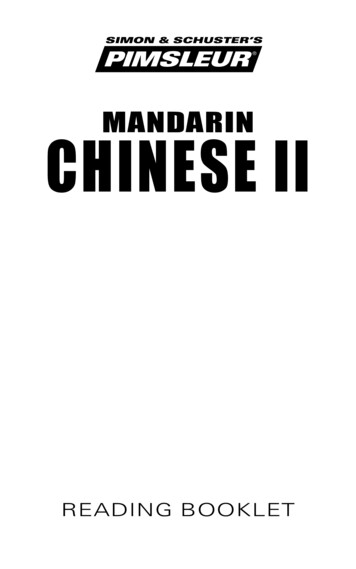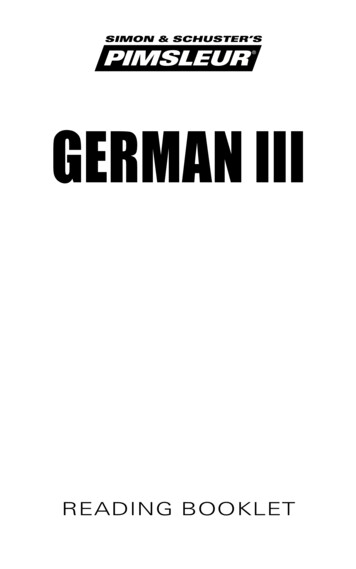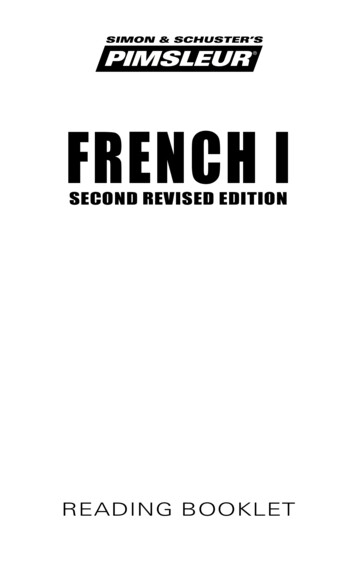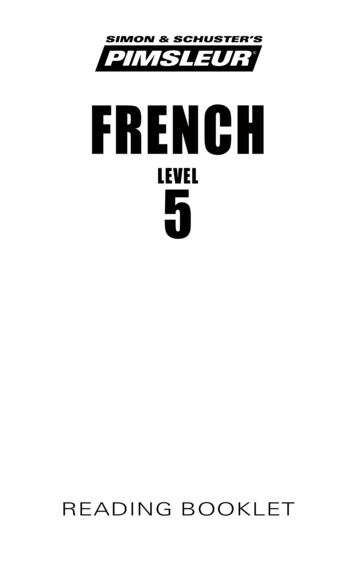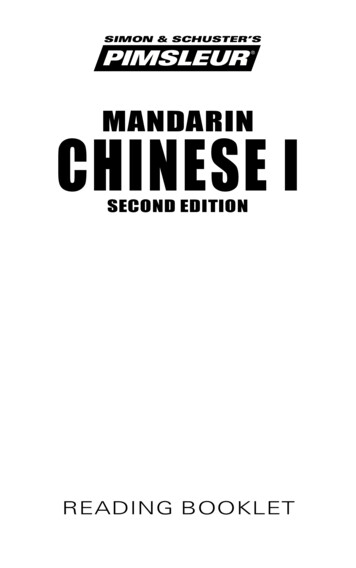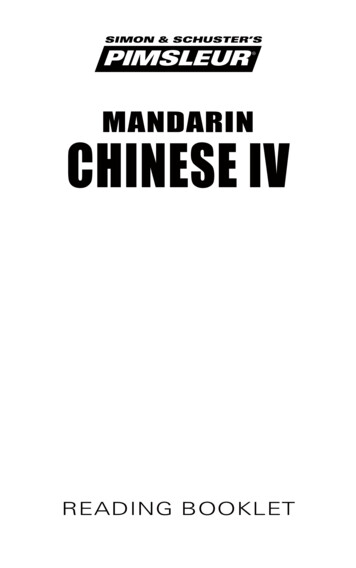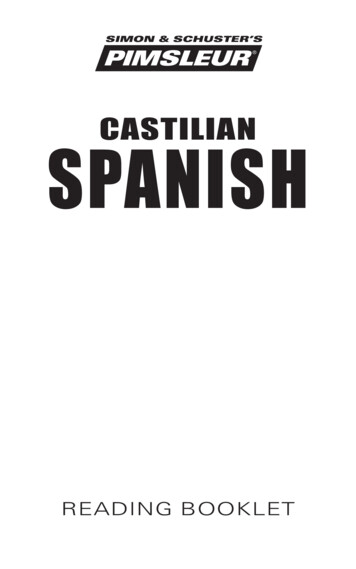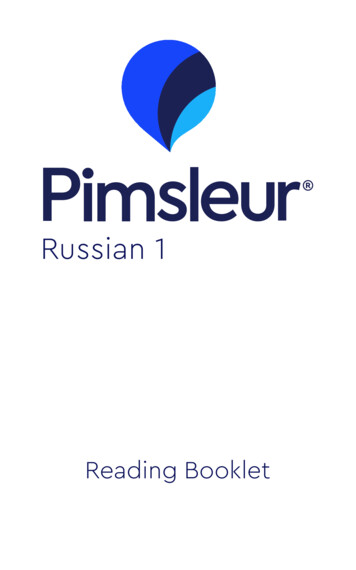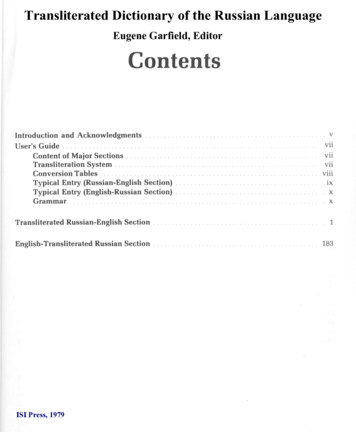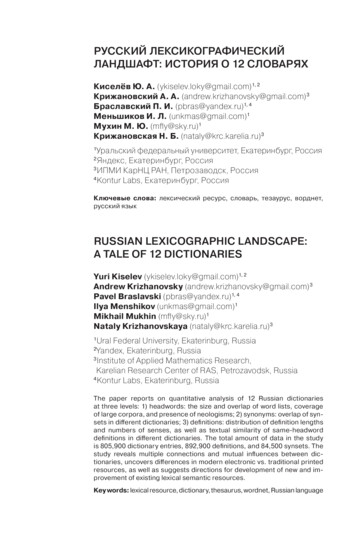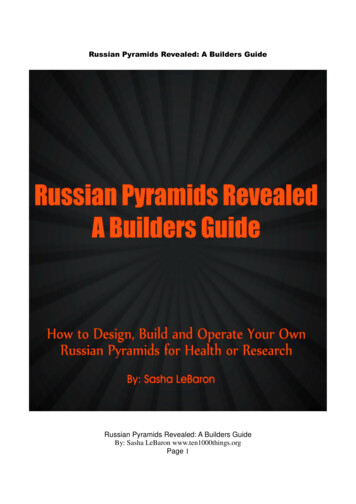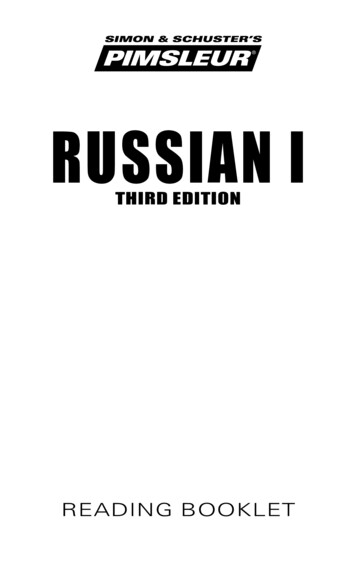
Transcription
SIMON & SCHUSTER’SPIMSLEUR Russian Ithird editionreading booklet
Travelers should always check with theirnation's State Department for currentadvisories on local conditions beforetraveling abroad.Graphic Design: Maia Kennedy and ‰ Recorded Program 2001 Simon & Schuster, Inc. Reading Booklet 2001 Simon & Schuster, Inc.Pimsleur is an imprint of Simon & Schuster Audio,a division of Simon & Schuster, Inc. Mfg. in USA.All rights reserved.
acknowledgmentsRussian Ithird editionVoicesEnglish-Speaking Instructor . . . . . . . . Ray BrownRussian-Speaking Instructor . . . . Dmitry KukunovFemale Russian Speaker . . . . . . . . Lena BurtsevaMale Russian Speaker . . . . . . . . Rustem SafronovCourse WriterSSergei Poletayev Christopher J. GaintyEditorsMary E. Green Beverly D. HeinleExecutive ProducerBeverly D. HeinleProducer & DirectorSarah H. McInnisRecording EngineersPeter S. Turpin Kelly SauxSimon & Schuster Studios, Concord, MAiii
For more information, call1-800-831-5497 or visit us atwww.Pimsleur.com
table of contentsReading LessonsIntroduction . . . . . . . . . . . . . . . . . . . . . . . . . . . . . 1Cyrillic Alphabet . . . . . . . . . . . . . . . . . . . . . . . . . 4Lesson One . . . . . . . . . . . . . . . . . . . . . . . . . . . . . 7Lesson Two . . . . . . . . . . . . . . . . . . . . . . . . . . . . . 8Lesson Three . . . . . . . . . . . . . . . . . . . . . . . . . . . . 9Lesson Four . . . . . . . . . . . . . . . . . . . . . . . . . . . . 10Lesson Five . . . . . . . . . . . . . . . . . . . . . . . . . . . . 11Lesson Six . . . . . . . . . . . . . . . . . . . . . . . . . . . . . 12Lesson Seven . . . . . . . . . . . . . . . . . . . . . . . . . . 13Lesson Eight . . . . . . . . . . . . . . . . . . . . . . . . . . . 14Lesson Nine . . . . . . . . . . . . . . . . . . . . . . . . . . . . 15Lesson Ten . . . . . . . . . . . . . . . . . . . . . . . . . . . . 16Lesson Eleven . . . . . . . . . . . . . . . . . . . . . . . . . . 17Lesson Twelve . . . . . . . . . . . . . . . . . . . . . . . . . . 18Lesson Thirteen . . . . . . . . . . . . . . . . . . . . . . . . . 19Lesson Fourteen . . . . . . . . . . . . . . . . . . . . . . . . 20Lesson Fifteen . . . . . . . . . . . . . . . . . . . . . . . . . . 21Lesson Sixteen . . . . . . . . . . . . . . . . . . . . . . . . . 22v
russian IIntroductionReading has been defined as the decoding ofgraphic material which represents the phonemicpatterns of the spoken language. Or to put it anotherway, reading consists of coming back to speechthrough the graphic symbols. In short, meaningis contained in the sounds of the spoken language.As the written form of any language does no morethan represent these sounds visually, speaking alanguage is the necessary first step to reading andunderstanding anything written in the language.Russian is written in the Cyrillic alphabet.This means that you will need to learn toassociate Russian sounds with what isprobably a new system of symbols. A complete listing of the Cyrillic alphabet andthe sounds of its letters follows, starting onpage 4. You should use this for reference only,however, as all the information you need to dothe readings is contained on the audio along withthe reading lessons.There are sixteen reading lessons for Russian I,Third Edition, all contained, along with instructions, at the end of the program. You may chooseto do the readings along with the lesson units,after every other unit or so, or you may want to1
russian IIntroduction (continued)wait and do them all together, after completing therest of the course. Feel free to repeat the readinglessons as often as needed for practice with theCyrillic alphabet and its sounds.Written Russian appears in the Cyrillic alphabet,the invention of which is traditionally creditedto Saint Cyril, a ninth-century Russian monk.Today, the Cyrillic alphabet is also used to represent many of the (mainly Slavic) languages spokenin Eastern Europe, ranging from Belorussianto Macedonian. Derived from the Greek alphabet,Cyrillic is a phonetic system, with some symbolsadded or altered to represent sounds unique tothese languages.If you are not familiar with the Cyrillic alphabet,you may first find that it takes some time to associatethe appropriate sounds with each letter and/or groupof letters. Therefore, we recommend that you takethe Reading Lessons at your own pace, repeatingeach until you feel comfortable proceeding with thenext. With a little effort, you will be astonished athow quickly you are reading Russian.2
russian IIntroduction (continued)The Cyrillic alphabet comprises 33 letters, listedin order, along with a guide to the sounds representedby each letter. You will note that many Russianletters (mostly vowels, but also some consonants)have more than one sound, depending on the amountof stress given to the letter or its position in the word.The pronunciations listed in the following “Guideto Pronunciation” are APPROXIMATE Englishequivalents and, as in any language, the sounds willvary slightly in different letter combinations.3
russian IThe Cyrillic AlphabetCyrillic letterGuide to Pronunciation(capital / small)Ааa as in father (when stressed);u(h) as in mumps (whenunstressed)Ббb as in betp at the end of a wordВвv as in vandalf at the end of a wordГгg as in gasolinek at the end of a wordsometimes v when in “г-о”combinationДдd as in deept at the end of a wordЕеye as in yesterday (whenstressed); sometimes e as inme (when unstressed)Ёёyo as in yorezh as in the middle of theЖжword treasureЗзz as in zoosometimes s at the end of a wordИиe as in eagle (when stressed);i as in big; or e as in beg(when unstressed)4
russian IThe Cyrillic Alphabet (continued)Cyrillic letter(capital / ФфХхЦцЧчШшЩщGuide to Pronunciationthe y at the end of greyk as in Kafkal as in Leninm as in Moscown as in nexto as in blow, but shorter (whenstressed); o as in ostrich (whenunstressed); sometimes u(h)(when unstressed at the end of aword)p as in Peterrolled rs as in sot as in topoo as in toolf as in findaspirated hts combination, as in pitsch combination, as in cheesesh as in shoelonger, softer sh sound5
russian IThe Cyrillic Alphabet (continued)Cyrillic letterGuide to Pronunciation(capital / small)Ъъhard sign - indicates thatpreceding letter should bepronounced wih a distinct soundfast euh-ee combinationЫыЬьsoft sign - indicates thatpreceding letter should bepronounced with more breathЭэe(h) in extrafast ee-ou combination, likeЮю-eau- in beautyЯяya in yawn but shorter (whenstressed); uh in grumble (whenunstressed)6
russian ILesson �pÎÓÚÓp‡Ï‡ã‡p‡7
russian ILesson �ÚpÓ Ï‡ÏÓ ÏÓ Ï‡Ï‡Â·ü ·.‰ÓÏ㇉‡‰ÂÎÓü ‰Â·Î.ü ‰Â·Π‰ÂÎÓ.8
russian ILesson �ωp‡Ï‡ ‰‚Ó‰‡ÇÓÎ ÒÓ‚‡ÇÓÚ ÒÓ‚‡.ÇÓÚ Ë‰Â΂ˉÂÎü ‚ˉÂÎ.ü ‚‡c ‚ˉÂÎ.9
russian ILesson � ‚ËÌÓÏpÂÒÚÓp‡Ì‚ pÂÒÚÓp‡Ì ·‚ ΉÂ· ü ‰Â· .·ÎËÌ·‡ÎÂÚ·ËÎÂÚÅËÎÂÚ Ì‡ ·‡ÎÂÚ10
russian ILesson �Ó‰Ë̇Π‰Ë‚Âp·Î ‰ÛÚpÓÛ‰‡pÛÎÂÚ‡ ü ÛÎÂÚ‡ ÛÚpÓÏ.Ô‡Ô‡‰ÛÔÎÓÔÓÌËχ ü ÔÓÌËχ .Ô‡ÍÂÚ͇pÚË̇̇ ͇pÚËÌ„ÓpÓ‰‚ „ÓpÓ‰ÂÍÌË„‡‚ ÍÌË„Â11
russian ILesson ÏÓ „ËÚ‡p‡Ô‡pÛÒÔÓ–pÛÒÒÍËü Ìe „Ó‚Óp --ü Ìe „Ó‚Óp ÔÓ–pÛÒÒÍË.‚ Ç „Ó‚ÓpËÚÂ.Ç „Ó‚ÓpËÚ ÔÓ–pÛÒÒÍË.à ‚ ÔÓÌËχÂÚÂ.ÒÎÛ ‡ ü ÒÎÛ ‡ .ü ‚‡Ò ÒÎÛ ‡ .çÓ Ì ÔÓÌËχ .12
russian ILesson 19.20.21.p‡·ÓÚ‡‰ÓpÓ„ÓÒÎË ÍÓÏ ‰ÓpÓ„ÓʺÚÓùÚÓ Â‰‡.ùÚÓ ÒÎË ÍÓÏ ‰ÓpÓ„Ó.‡ʺpÓÔÓpÚ‚ ‡ʺpÓÔÓpÚå ‰ÂÏ ‚ ‡ʺpÓÔÓpÚ.ıηıÓÚËÚÂÇ ıÓÚËÚÂ.Ç ıÓÚËÚ ıη‡?ıη‡ / ıη ÓÍÓ·‰Ç Î ·ËÚ ÓÍÓ·‰.Ï‡Ú Ï‡ÚÔ Ú ÂÒÚ è Ú ËÎË ÂÒÚ ?13
russian ILesson 19.20.åÌ Ìp‡‚ËÚÒ .åÌ Ìp‡‚ËÚÒ ÔË‚Ó.Ç ıÓÚËÚ ‚Ë̇?ıÓ ÛïÓ Û ‚ËÌÓ.Ú ÂÚ peÚ Ò ‡ ÂpÂÔ‡ı‡Á̇ÂÚÂÇ Á̇ÂÚÂ.Á‰ÂÒ Á‰ÓpÓ‚ eü Ì Á̇ .ÁÛ· ·ÓÎ ÓÈÅÓÎ ÓÈ Ú‡ÚpÌÓ‚ ÈçÓ‚ È „Ó‰ë çÓ‚ Ï „Ó‰ÓÏ!14
russian ILesson 9.20.ÍÓÏËÚÂÚÇ ËÁ ÍÓÏËÚÂÚ‡!çÂÚ, ʺÚÓ Ì Ôp‡‚‰‡.ü Ì pÛÒÒÍËÈ.‡ÏÂpË͇̈ü ‡ÏÂpË͇̈.ˆ‡ÔÎ ˆÂpÂÏÓÌË Î͇ˆ ÔÎ ÌÓÍÊÛÍ ÊËÍÊË‚ ÚÂɉ ‚ ÊË‚ ÚÂ?ü ÊË‚Û ‚ Ì Ìp‡‚ËÚÒ ˆËpÍ.̇ „èÓȉ Ï Ì‡ „.15
russian ILesson .20. ‡ ‡„pÛ ‡Á‡ ˆÒÓ·‡Í‡ÔÎÓıÓÔÎÓı‡ èÎÓı‡ ÍËÈ Ù·„ÔÓ‰ ÂÁ‰ÒÂÎ / Ò ÂÎÒ Âı‡Ú ü Ò Â‰Û. Ë Ë / ËÚ ÎÍ / ÎÍΠ‚ Âı‡Ú 16
russian ILesson .É‰Â à‚‡Ì?éÌ Ì Á‰ÂÒ .åÓÊÂÚ · Ú , ÓÌ Ú‡Ï.éÌ Ì ‚ „ÓÒÚËÌˈÂ.ÉÓÒÚËÌˈ‡ «àÌÚÛpËÒÚ»éÎ „‡ ‚ „ÓÒÚËÌˈÂ.é̇ Ú‡Ï.B Á̇ÂÚÂ?í Á̇ ?çÂÚ, Ì Á̇ . ü  Ì Á̇ .ç Á̇ , „‰Â à‚‡Ì.̇ í‚ÂpÒÍÓÈ ÛÎˈÂåÓıÓ‚‡ ÛÎˈ‡ÁÛ·Ó‚ëÍÓÎ ÍÓ ÁÛ·Ó‚ Û ‡ÍÛÎ ?ëÔpÓÒËÚÂ Û à‚‡Ì‡.17
russian ILesson Twelve1.2.3.4.5.6.7.8.9.10.11.12.13.14.15.å Ëı‡ÂÏÙ‡·pË͇Öı‡Ú ̇ ‡‚ÚÓ·ÛÒÂ.̇ ‡ÔÚÂÍep‡Á ÂÁ‰ÔÓʇÎÛÈÒÚaÑÓ Ò‚Ë‰‡ÌË .«ÇÓÈ̇ Ë ÏËp»ü Î ·Î Π‡.ÅÓpËÒ, Ú Ì Ôp‡‚.ü p‡Á‰p‡Ê Ì.èÓ ÂÏÛ?ïη ÔÓ‰„ÓpÂÎ.è Úp ÇÂÎËÍËÈŇϷ‡p‰Ë !18
russian ILesson Òڇ˄p‡ O ÂÌ ıÓpÓ Ó.«Äp„ÛÏÂÌÚ Ë Ù‡ÍÚ »«ûÌ È Ì‡ÚÛp‡ÎËÒÚ»å ËÚ‡ÂÏ „‡ÁÂÚÛ.ùÚÓ ÏÓ „‡ÁÂÚ‡.ü ‰ÓÎÊÂÌ Ò͇Á‡Ú «ÉÂÓp„Ë ».Ç ÏÓÈ Ò‚Ó ÎˈÓ.燂‰ËÚ ÔÓp ‰ÓÍ.ç ÍÛpËÚÂ, ÔÓʇÎÛÈÒÚ‡.çÂÚ ‰ χ ·ÂÁ Ó„Ì .͇ÒÚp Î ì ‚‡Ò ÂÒÚ ÒÎÓ‚‡p ?19
russian ILesson �ÒÏÓ̇‚ÚûpËÈ É‡„‡pËÌ ÍÓÒÏÓ̇‚Ú.éÌ ÔÂp‚ È ÍÓÒÏÓ̇‚Ú.pÂ͇pÂ͇ ÇÓ΄‡ùÚÓ ·ÓÎ ‡ pÂ͇.ó pÌÓ ÏÓpÂïÓ Û p ·Û Í ÛÊËÌÛ.ü Ì Π·Î  .ì ‚‡Ò ÂÒÚ ÍÓÏÔ ÚÂp?ÙÓÚÓ„p‡ÙË ÔËpÓÊÓÍÔËpÓ„ËÏÓpÓÊÂÌÓ ‡ Î Íü Ó ÂÌ „ÓÎÓ‰ÂÌ!20
russian ILesson �p‡‰Óʉ ̇ pÂÍÂÔ‡ÔÓpÓÚÌËÍ Â·ÛpÂÍËùÚÓ „pÛÁËÌÒÍÓ ·Î ‰Ó.ä‡Í ÔpÓÈÚË ‚ ÏÂÚpÓ?à‰ËÚ Ôp ÏÓ, ‡ ÔÓÚÓÏ Ì‡Ôp‡‚Ó.„‡ÎÂp ípÂÚ ÍÓ‚Ò͇ ɉ ípÂÚ ÍÓ‚Ò͇ „‡ÎÂp ?ùÚÓ ÏÓÈ ‰pÛ„ àÓÒËÙ.éÌ ·ÓÎ ÓÈ ÓpË„Ë̇Î.21
russian ILesson 8.ü Á‡·ÓÎÂÎ.ì ÏÂÌ ·ÓÎËÚ „ÓÎÓ‚‡.ë‚ËÌ͇ÇÂÚp � ÒÍÓp‡ ÔÓÏÓ ÎÂ͇pÒÚ‚‡·ÓÎ Ìˈ‡ÎÛ ÂåÌ ÛÊ ÎÛ Â.CÔ‡ÒË·Ó ·ÓÎ ÓÂ!å Ò ‚‡ÏË --å Ò ‚‡ÏË ÏÓÊÂÏ ÔÓÛÊËÌ‡Ú ‚ÏÂÒÚÂ?BaÏ Ìp‡‚ËÚÒ pÂÒÚÓp‡Ì «Äp·‡Ú»?ïÓpÓ Ó. íÓ„‰‡ ‰Ó ‚ Âp‡.ÑÓ Ò‚Ë‰‡ÌË .22
Pimsleur is an imprint of . Russian is written in the Cyrillic alphabet. This means that you will need to learn to associate Russian sounds with what is probably a new system of symbols. A com-plete listing of the Cyrillic alphabet and the sounds of its letters follows, starting on page 4. You should use this for reference only, however, as all the information you need to do the readings .
